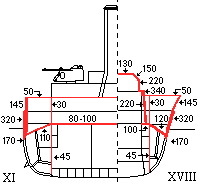History of Bismarck battleship (part 3)
· British Empire 525,000 tons (533,400 mt).
· France 175,000 tons (177,800 mt).
· Italy 175,000 tons (177,800 mt).
· Japan 315,000 tons (320,040 mt).
· Searchlight deck (Scheinwerferdeck).
· Lower searchlight deck (Unteres Scheinwerferdeck).
· Admiral’s bridge (Admiralsbrücke).
· Upper mast deck (Oberes Mastdeck).
· Lower mast deck (Unteres Mastdeck).
· Bridge deck (Brückendeck).
· Lower bridge deck (Unteres Brückendeck).
· First deck (Aufbaudeck).
· Upper deck (Oberdeck).
· Battery deck (Batteriedeck).
· Main deck / Armour deck (Zwischendeck [tweendeck] / Panzerdeck).
· Upper platform deck (Oberes Plattformdeck).
· Middle platform deck (Mittleres Plattformdeck).
· Lower platform deck (Unteres Plattformdeck).
· Stowing [stowage] (Stauung).
 Scharnhorst cross section |  Bismarck cross section |
| Displacement: · Official: · Standard: · Full load: | 26,420 mt 32,060 mt 38,430 mt | 35,560 mt 41,700 mt 50,900 mt |
| Dimensions: · Waterline length: · Beam: · Draught: | 226 meters 30 meters 8.6 meters | 241.5 meters 36 meters 9.3 meters |
| Armour protection: · Upper belt: · Lower main belt: · Main turrets: · Upper deck: · Third armour deck: · Conning tower: · Torpedo bulkhead: · Protected length 1: · PC/TC 2: | 45 mm 350 mm 100-340 mm 50 mm 80-110 mm 200-350 mm 45 mm 68% (153 meters) 16/21 | 145 mm 320 mm 130-360 mm 50-80 mm 80-120 mm 220-350 mm 45 mm 70% (170 meters) 17/22 |
| Armament: · Main: · Secondary: · Anti-aircraft: | 9 x 28cm/L54.5 12 x 15cm/L55 14 x 10.5cm/L65 16 x 3.7cm/L83 14 x 2cm | 8 x 38cm/L52 12 x 15cm/L55 16 x 10.5cm/L65 16 x 3.7cm/L83 18 x 2cm |
| Propulsion plant: | Three turbine sets 125,000 hp | Three turbine sets 138,000 hp |
| Speed: | ||
| Endurance: | ||
| Fuel capacity: | ||
| Aircraft: | ||
| Crew: |
Không có nhận xét nào:
Đăng nhận xét